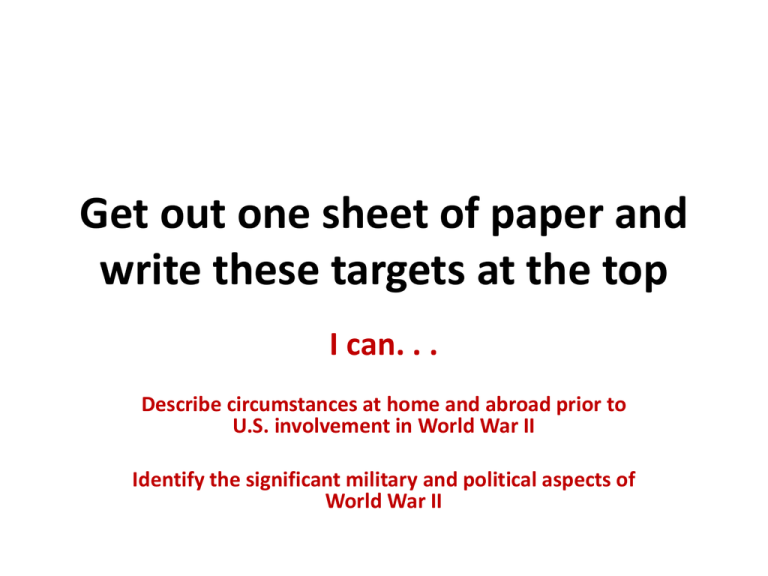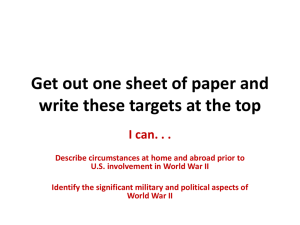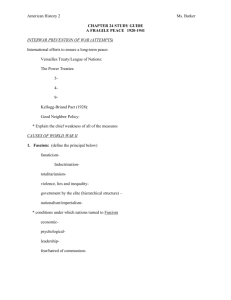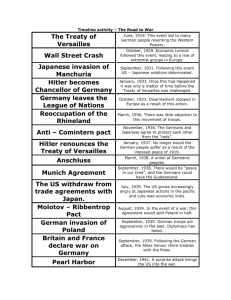WW2
advertisement

Get out one sheet of paper and write these targets at the top I can. . . Describe circumstances at home and abroad prior to U.S. involvement in World War II Identify the significant military and political aspects of World War II This must be completed TODAY! • You will need a GREEN U.S. History book and one partner (as well as) your one sheet of paper with the targets on the top. – Turn to page 542 • Using the text, complete Dictators Threaten World Peace, parts A and B • Using the text, complete War in Europe, parts A and B – Japanese Aggression (questions on the back) – Political Cartoon • 1. Identify the figures in the cartoon? Who does each represent? • 2. What is meant by the sign, “Follies of 1936”? You may need to use your book. • 3. What message is the cartoonist sending to the reader? • 4. Give this cartoon a caption or title? – Franklin D. Roosevelt’s “Quarantine Speech” – answer the three questions at the bottom WORLD WAR II • was the deadliest conflict in human history by far. The exact figures will never be known, but as many as 50–60 million people around the world lost their lives as a result of conflict between September 1939 and August 1945. At least one-third were civilians: killed, maimed, or made homeless by aerial bombing, starvation, disease, or other causes Military Deaths (in approximate figures) • • • • • • • • • • • • • • • • Soviet Union: 7 million (at least; the actual figure may be as high as 13 million) Germany: 4 million China: 3.5 million Japan: 1.2 million United States: 405,399 Yugoslavia: 300,000 British Commonwealth: 344,000 (United Kingdom: 244,000; Canada: 37,000; India 24,000; Australia 23,000; New Zealand 10,000; South Africa 6,000) Romania: 200,000 France: 200,000 Italy: 165,000 Hungary: 120,000 Poland: 120,000 Czechoslovakia: 10,000 Civilian Deaths (in approximate figures) • • • • • • • • • • • • • • China: 10 million Soviet Union: 7 million (at least) Poland: 6 million Germany: 1.6 million (up to 2 million ethnic Germans from Eastern Europe may also have died) Yugoslavia: 1 million Romania: 465,000 France: 400,000 Czechoslovakia: 330,000 Japan: 380.000 Hungary: 280,000 Greece: 250,000 Netherlands: 190,000 United Kingdom: 60,000 Essential Question: •Was World War 2 inevitable? Major Causes of World War II Attempts at Peace After WWI • League of Nations – U.S. never joined – No teeth/enforcement • Naval Disarmament (Washington Naval Conference and London Naval Conference) – Major countries pledge to reduce warships, cruisers, and destroyers • Nine-Power Treaty – Support equal trading rights in China and respect for China’s independence • Kellogg-Briand Pact – Agreement to outlaw war as an “instrument of national policy”; 60 nations. But no enforcement! Aggression • • • • • • • 1931 – Japanese invasion of Manchuria 1935 – Italian invasion of Ethiopia 1935 – Germany reintroduces conscription 1936 – Germany remilitarizes the Rhineland 1936 – Spanish civil war won by Franco 1937 – Japanese of China 1938 – German annexing of Austria • 1938 – Munich Pact – Germany gets the Sudetenland – Policy of appeasement • 1939 – Italy invades and annexes Albania • 1939 – Germany demands the return of Danzig and the Polish Corridor • 1939 – Soviet-German Non-Aggression Pact – No fighting each other; divide Poland – Really it gave the Soviets time • Sept. 1, 1939, Germany invades Poland What the U.S. was doing • Passing Neutrality Acts (1935, 1937) – Prohibited the sale of war implements to belligerents (later includes steel, oil) – Prohibited loans to belligerents – Prohibited Americans from sailing on ships of belligerents – Restricted entry of American merchant ships into war zones • FDR’s Quarantine Speech 1937 – Warned that the western hemisphere may be attacked – World lawlessness was an “epidemic of physical disease” – Aggressive nations must be quarantined – This was a test of America’s will to engage • American’s were not ready to reengage in conflict However, • By 1941 things change – Initial German successes • Poland, Denmark, Norway, France, and almost Britain. . . done – U.S. changes its tone • Neutrality Act of 1939 – cash and carry • Selective Service Act of 1940 – 1st peacetime draft • Destroyer-Naval Base Deal (1940) – 50 destroyers for military bases in Western Hemisphere • Lend-Lease Act (1941) – garden hose analogy ($50 billion) • Atlantic Charter (1941) – four freedoms; U.N. proposal • Embargo of Japan – no aviation fuel or scrap iron; froze their American assets Atlantic Charter • The U.S. and Britain – Seek no territorial gain – Respected the right of all people to choose their own form of government – “We look forward to a world founded upon four essential human freedoms. The first is freedom of speech and expression--everywhere in the world. The second is freedom of every person to worship God in his own way-everywhere in the world. The third is freedom from want . . . everywhere in the world. The fourth is freedom from fear . . . anywhere in the world.” – Nations must abandon the use of force – We need to establish a “system of general security.” –the United Nations the Coming of War • Japan had become a highly militarized state, intent on expanding into China & beyond • U.S. attitudes towards the Japanese – years of the “yellow peril” • U.S. bans the sale of aviation fuel and scrap metal to the Japanese; reduces their oil supplies by 90% • The Dutch and French can’t hold on to their Asian possessions • U.S. freezes Japanese assets and places an all-out trade embargo on Japan • Dec. 7, 1941 – 20 ships; 350 aircraft 2,400+ dead; 1,200 wounded – The awakening of a sleeping giant http://www.youtube.com/watch?v= 3e99lfmmDN0 – http://www.youtube.com/watch?v= mQm_I3GpaGM Japanese Internment Timeline • 1891 - Japanese immigrants arrive on the mainland U.S. for work primarily as agricultural laborers. • 1906 - The San Francisco Board of Education passes a resolution to segregate children of Chinese, Japanese, and Korean ancestry. • 1913 - California passes the Alien Land Law, forbidding "all aliens ineligible for citizenship" from owning land. • 1924 - Congress passes the Immigration Act of 1924 effectively ending all Japanese immigration to the U.S. • November 1941 - Munson Report released (Document B). • December 7, 1941 - Japan bombs U.S. ships and planes at the Pearl Harbor military base in Hawaii. • February 19, 1942 - President Roosevelt signs Executive Order 9066 authorizing military authorities to exclude civilians from any area without trial or hearing. Under the leadership of War Relocation Authority. The Pacific Theater • http://ww2.wwarii.com/var/albums/maps_do cuments/pacific_theater/ww2-asiaoverview.gif 4 phases of the Pacific Theater • 1st: Dec 41-June 42: Japanese Offensive • 2nd: June 42-late 43: Stalemate • 3rd: late 43-Sept 45: Allied Offensive – MacArthur’s amphibious operation; island hopping – Nimitz’s naval campaign – Both merge to invade the Philippines, Iwo Jima, Okinawa • 4th: summer 45: Firebombing







